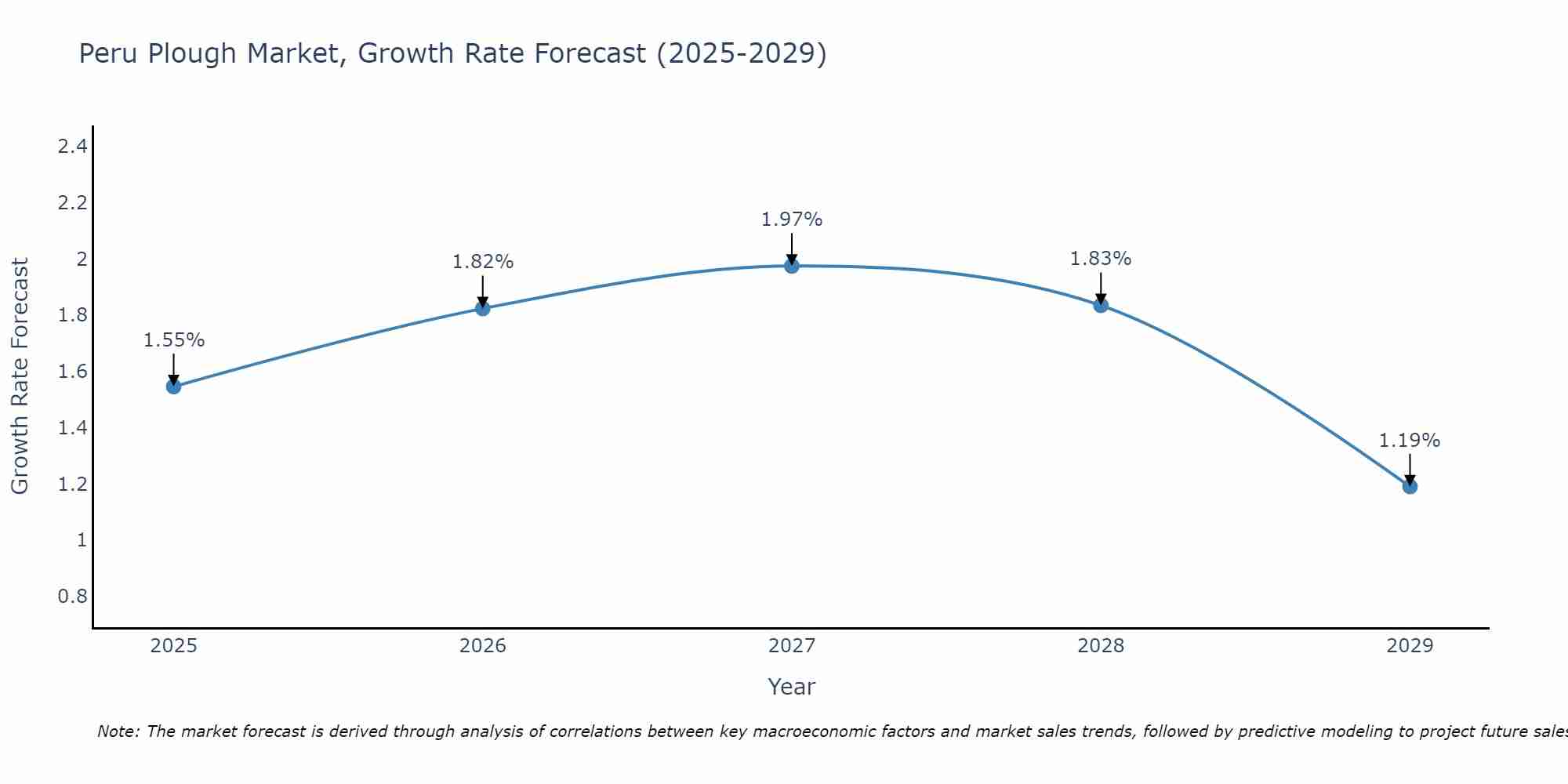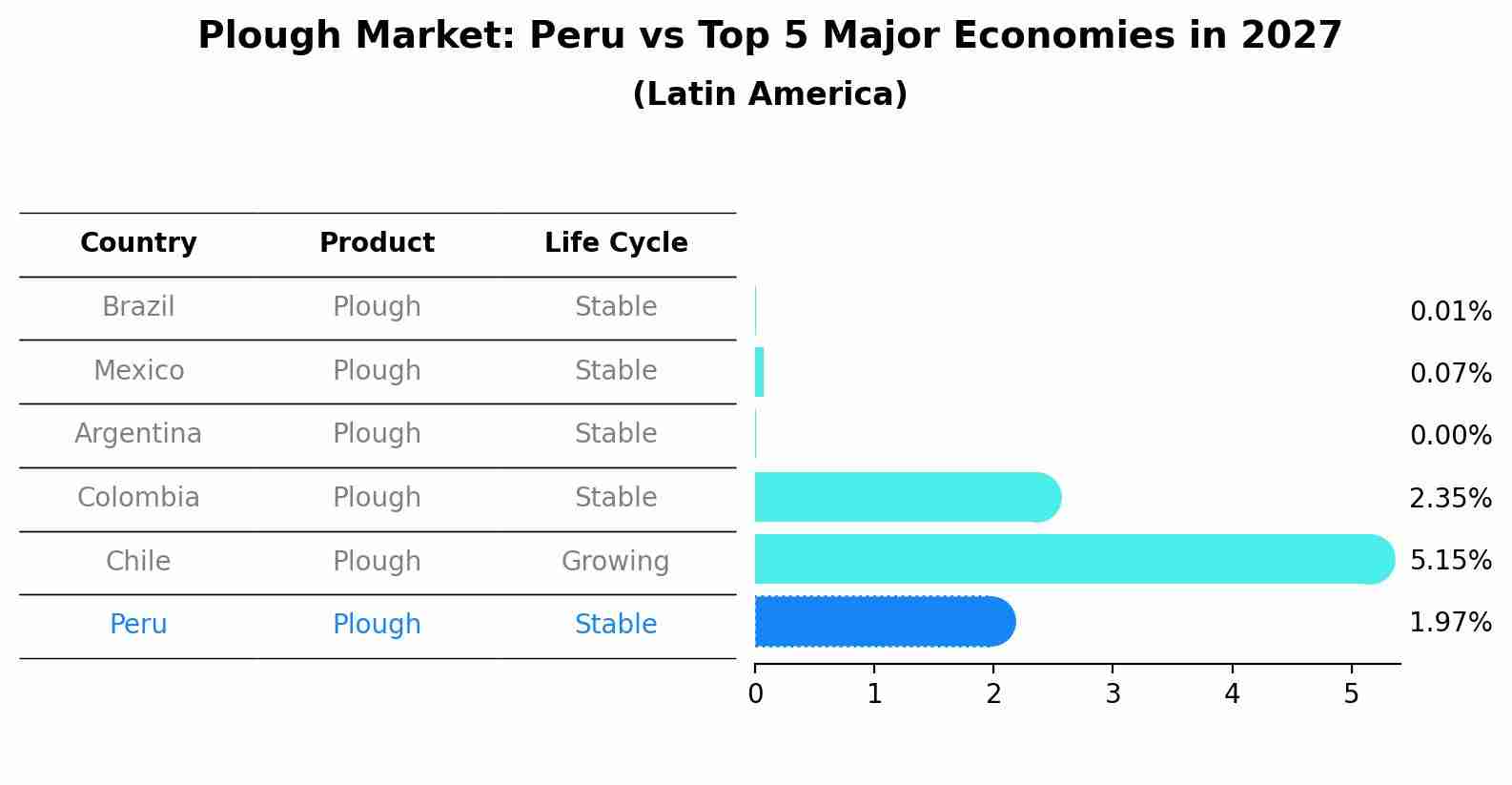Peru Plough Market (2025-2031) | Industry, Companies, Value, Share, Analysis, Size, Forecast, Growth, Outlook, Revenue & Trends
| Product Code: ETC051466 | Publication Date: Jan 2021 | Updated Date: Jun 2025 | Product Type: Report | |
| Publisher: 6Wresearch | Author: Bhawna Singh | No. of Pages: 70 | No. of Figures: 35 | No. of Tables: 5 |
Peru Plough Market Size Growth Rate
The Peru Plough Market is projected to witness mixed growth rate patterns during 2025 to 2029. The growth rate begins at 1.55% in 2025, climbs to a high of 1.97% in 2027, and moderates to 1.19% by 2029.

Plough Market: Peru vs Top 5 Major Economies in 2027 (Latin America)
By 2027, Peru's Plough market is forecasted to achieve a stable growth rate of 1.97%, with Brazil leading the Latin America region, followed by Mexico, Argentina, Colombia and Chile.

Peru Plough Market Overview
The Peru plough market is characterized by a mix of traditional and modern ploughing techniques, with a growing trend towards mechanization in larger agricultural operations. Traditional ploughs made of wood or metal are still widely used by small-scale farmers in rural areas, while modern tractor-mounted ploughs are becoming more popular among commercial farms. The market is driven by factors such as increasing demand for agricultural productivity, government support for mechanization initiatives, and the adoption of sustainable farming practices. Key players in the Peru plough market include local manufacturers, international agricultural machinery companies, and government agencies promoting agricultural development. Market competition is moderate, with a focus on product quality, pricing, and after-sales services to cater to the diverse needs of farmers across different regions of Peru.
Peru Plough Market Trends
The Peru Plough Market is experiencing notable trends in the adoption of modern ploughing technologies among farmers. There is a growing preference for more efficient and advanced ploughing equipment that can improve productivity and reduce manual labor. Additionally, sustainability and environmental concerns are driving the demand for eco-friendly ploughing solutions that minimize soil erosion and promote soil health. Farmers are also increasingly looking for versatile ploughing equipment that can be used in various types of terrain and farming conditions. As technology continues to advance, we can expect further innovations in the Peru Plough Market that cater to the evolving needs and preferences of farmers in the region.
Peru Plough Market Challenges
In the Peru plough market, some of the key challenges faced include increasing competition from foreign manufacturers offering lower-priced alternatives, fluctuating input costs such as steel and labor, limited access to modern technology and machinery for small-scale farmers, and the impact of climate change on agricultural productivity. Additionally, there are challenges related to the lack of government support and infrastructure development in rural areas, which can hinder the adoption of advanced ploughing techniques. Market players also need to navigate complex regulatory environments and adhere to quality standards to ensure product competitiveness and consumer trust. Overall, overcoming these challenges requires a combination of innovation, strategic partnerships, and targeted marketing efforts to effectively cater to the diverse needs of farmers in the Peru plough market.
Peru Plough Market Investment Opportunities
The Peru Plough Market offers promising investment opportunities due to the country`s growing agricultural sector and increasing demand for modern farming equipment. With the government`s focus on improving agricultural productivity and infrastructure, there is a growing need for advanced ploughing machinery to enhance efficiency and yield. Investors can consider opportunities in manufacturing or distributing ploughs with innovative features such as GPS technology, adjustable settings, and improved durability to cater to the evolving needs of Peruvian farmers. Additionally, investing in research and development to create specialized ploughs tailored to the unique characteristics of Peru`s diverse agricultural landscape can provide a competitive edge in this market. Overall, the Peru Plough Market presents a favorable environment for investors looking to capitalize on the country`s expanding agricultural industry.
Peru Plough Market Government Policy
The Peruvian government has implemented various policies to support the plough market in Peru. These policies include subsidies for plough manufacturers to encourage local production and reduce import dependency. Additionally, the government has introduced quality standards and regulations to ensure the safety and effectiveness of ploughs in the market. To promote innovation and competitiveness, the government has also provided financial support and incentives for research and development in the plough manufacturing sector. Moreover, the government has focused on promoting sustainable practices in plough production to minimize environmental impact. Overall, these policies aim to boost the growth of the plough market in Peru, support local manufacturers, and enhance the efficiency and sustainability of agricultural practices in the country.
Peru Plough Market Future Outlook
The Peru plough market is expected to witness steady growth in the coming years due to the increasing adoption of mechanized agricultural practices in the country. Factors such as the government`s focus on promoting modern farming techniques, rising demand for higher crop yield, and the need for efficient land cultivation methods are driving the market growth. Additionally, advancements in plough technology, such as the introduction of precision farming equipment and sustainable farming practices, are expected to further boost market expansion. With a growing emphasis on improving agricultural productivity and sustainability, the Peru plough market is poised for a positive outlook, presenting opportunities for both domestic manufacturers and international players looking to tap into the country`s evolving agricultural sector.
Key Highlights of the Report:
- Peru Plough Market Outlook
- Market Size of Peru Plough Market, 2024
- Forecast of Peru Plough Market, 2031
- Historical Data and Forecast of Peru Plough Revenues & Volume for the Period 2021 - 2031
- Peru Plough Market Trend Evolution
- Peru Plough Market Drivers and Challenges
- Peru Plough Price Trends
- Peru Plough Porter's Five Forces
- Peru Plough Industry Life Cycle
- Historical Data and Forecast of Peru Plough Market Revenues & Volume By Types for the Period 2021 - 2031
- Historical Data and Forecast of Peru Plough Market Revenues & Volume By Traditional Plough for the Period 2021 - 2031
- Historical Data and Forecast of Peru Plough Market Revenues & Volume By Modern Plough for the Period 2021 - 2031
- Historical Data and Forecast of Peru Plough Market Revenues & Volume By Specialist Plough for the Period 2021 - 2031
- Historical Data and Forecast of Peru Plough Market Revenues & Volume By Application for the Period 2021 - 2031
- Historical Data and Forecast of Peru Plough Market Revenues & Volume By Farm for the Period 2021 - 2031
- Historical Data and Forecast of Peru Plough Market Revenues & Volume By Individual Farming for the Period 2021 - 2031
- Peru Plough Import Export Trade Statistics
- Market Opportunity Assessment By Types
- Market Opportunity Assessment By Application
- Peru Plough Top Companies Market Share
- Peru Plough Competitive Benchmarking By Technical and Operational Parameters
- Peru Plough Company Profiles
- Peru Plough Key Strategic Recommendations
Frequently Asked Questions About the Market Study (FAQs):
1 Executive Summary |
2 Introduction |
2.1 Key Highlights of the Report |
2.2 Report Description |
2.3 Market Scope & Segmentation |
2.4 Research Methodology |
2.5 Assumptions |
3 Peru Plough Market Overview |
3.1 Peru Country Macro Economic Indicators |
3.2 Peru Plough Market Revenues & Volume, 2024 & 2031F |
3.3 Peru Plough Market - Industry Life Cycle |
3.4 Peru Plough Market - Porter's Five Forces |
3.5 Peru Plough Market Revenues & Volume Share, By Types, 2024 & 2031F |
3.6 Peru Plough Market Revenues & Volume Share, By Application, 2024 & 2031F |
4 Peru Plough Market Dynamics |
4.1 Impact Analysis |
4.2 Market Drivers |
4.3 Market Restraints |
5 Peru Plough Market Trends |
6 Peru Plough Market, By Types |
6.1 Peru Plough Market, By Types |
6.1.1 Overview and Analysis |
6.1.2 Peru Plough Market Revenues & Volume, By Types, 2016 - 2031F |
6.1.3 Peru Plough Market Revenues & Volume, By Traditional Plough, 2016 - 2031F |
6.1.4 Peru Plough Market Revenues & Volume, By Modern Plough, 2016 - 2031F |
6.1.5 Peru Plough Market Revenues & Volume, By Specialist Plough, 2016 - 2031F |
6.2 Peru Plough Market, By Application |
6.2.1 Overview and Analysis |
6.2.2 Peru Plough Market Revenues & Volume, By Farm, 2016 - 2031F |
6.2.3 Peru Plough Market Revenues & Volume, By Individual Farming, 2016 - 2031F |
7 Peru Plough Market Import-Export Trade Statistics |
7.1 Peru Plough Market Export to Major Countries |
7.2 Peru Plough Market Imports from Major Countries |
8 Peru Plough Market Key Performance Indicators |
9 Peru Plough Market - Opportunity Assessment |
9.1 Peru Plough Market Opportunity Assessment, By Types, 2024 & 2031F |
9.2 Peru Plough Market Opportunity Assessment, By Application, 2024 & 2031F |
10 Peru Plough Market - Competitive Landscape |
10.1 Peru Plough Market Revenue Share, By Companies, 2024 |
10.2 Peru Plough Market Competitive Benchmarking, By Operating and Technical Parameters |
11 Company Profiles |
12 Recommendations |
13 Disclaimer |
- Single User License$ 1,995
- Department License$ 2,400
- Site License$ 3,120
- Global License$ 3,795
Search
Thought Leadership and Analyst Meet
Our Clients
Related Reports
- Germany Breakfast Food Market (2026-2032) | Industry, Share, Growth, Size, Companies, Value, Analysis, Revenue, Trends, Forecast & Outlook
- Australia Briquette Market (2025-2031) | Growth, Size, Revenue, Forecast, Analysis, Trends, Value, Share, Industry & Companies
- Vietnam System Integrator Market (2025-2031) | Size, Companies, Analysis, Industry, Value, Forecast, Growth, Trends, Revenue & Share
- ASEAN and Thailand Brain Health Supplements Market (2025-2031) | Strategy, Consumer Insights, Analysis, Investment Trends, Opportunities, Growth, Size, Share, Industry, Revenue, Segments, Value, Segmentation, Supply, Forecast, Restraints, Outlook, Competition, Drivers, Trends, Demand, Pricing Analysis, Competitive, Strategic Insights, Companies, Challenges
- ASEAN Bearings Market (2025-2031) | Strategy, Consumer Insights, Analysis, Investment Trends, Opportunities, Growth, Size, Share, Industry, Revenue, Segments, Value, Segmentation, Supply, Forecast, Restraints, Outlook, Competition, Drivers, Trends, Demand, Pricing Analysis, Competitive, Strategic Insights, Companies, Challenges
- Europe Flooring Market (2025-2031) | Outlook, Share, Industry, Trends, Forecast, Companies, Revenue, Size, Analysis, Growth & Value
- Saudi Arabia Manlift Market (2025-2031) | Outlook, Size, Growth, Trends, Companies, Industry, Revenue, Value, Share, Forecast & Analysis
- Uganda Excavator, Crane, and Wheel Loaders Market (2025-2031) | Strategy, Consumer Insights, Analysis, Investment Trends, Opportunities, Growth, Size, Share, Industry, Revenue, Segments, Value, Segmentation, Supply, Forecast, Restraints, Outlook, Competition, Drivers, Trends, Demand, Pricing Analysis, Competitive, Strategic Insights, Companies, Challenges
- Rwanda Excavator, Crane, and Wheel Loaders Market (2025-2031) | Strategy, Consumer Insights, Analysis, Investment Trends, Opportunities, Growth, Size, Share, Industry, Revenue, Segments, Value, Segmentation, Supply, Forecast, Restraints, Outlook, Competition, Drivers, Trends, Demand, Pricing Analysis, Competitive, Strategic Insights, Companies, Challenges
- Kenya Excavator, Crane, and Wheel Loaders Market (2025-2031) | Strategy, Consumer Insights, Analysis, Investment Trends, Opportunities, Growth, Size, Share, Industry, Revenue, Segments, Value, Segmentation, Supply, Forecast, Restraints, Outlook, Competition, Drivers, Trends, Demand, Pricing Analysis, Competitive, Strategic Insights, Companies, Challenges
Industry Events and Analyst Meet
Whitepaper
- Middle East & Africa Commercial Security Market Click here to view more.
- Middle East & Africa Fire Safety Systems & Equipment Market Click here to view more.
- GCC Drone Market Click here to view more.
- Middle East Lighting Fixture Market Click here to view more.
- GCC Physical & Perimeter Security Market Click here to view more.
6WResearch In News
- Doha a strategic location for EV manufacturing hub: IPA Qatar
- Demand for luxury TVs surging in the GCC, says Samsung
- Empowering Growth: The Thriving Journey of Bangladesh’s Cable Industry
- Demand for luxury TVs surging in the GCC, says Samsung
- Video call with a traditional healer? Once unthinkable, it’s now common in South Africa
- Intelligent Buildings To Smooth GCC’s Path To Net Zero


















